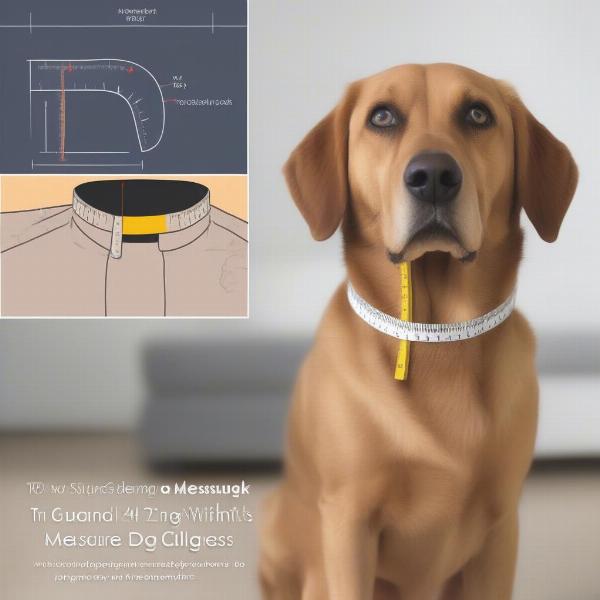Dog guard collars are essential tools for protecting your furry friends from potential dangers. Whether you’re concerned about wildlife encounters, traffic hazards, or simply want to give your dog more freedom to explore, choosing the right guard collar can significantly enhance their safety and well-being. This guide will cover everything you need to know about dog guard collars, from understanding their different types and features to selecting the perfect fit for your canine companion.
Types of Dog Guard Collars
Dog guard collars come in various styles, each designed for specific purposes. Understanding these differences will help you choose the most appropriate collar for your dog’s individual needs.
Livestock Guardian Dog Collars
Livestock guardian dog collars, as the name suggests, are designed for working dogs who protect livestock from predators. These collars are typically made from heavy-duty materials like leather or nylon and often feature spikes or metal plates to deter attacks from coyotes, wolves, or other predators. While these collars are extremely effective for their intended purpose, they are generally not suitable for everyday use or for dogs who don’t work with livestock.
Electric Guard Collars
Electric guard collars, sometimes referred to as invisible fences or containment systems, use a radio signal to create a boundary for your dog. When the dog approaches the boundary, the collar emits a warning tone, and if the dog continues, it delivers a mild electric shock. These collars can be effective for containing dogs within a designated area, but they require proper training and careful consideration of the dog’s temperament. Some dog owners prefer not to use these collars due to ethical concerns surrounding the use of electric shocks.
Bark Control Collars
While not strictly “guard” collars, bark control collars can play a role in protecting your dog by preventing excessive barking. These collars use various methods to deter barking, such as vibrations, ultrasonic sounds, or citronella spray. Excessive barking can attract unwanted attention, potentially putting your dog at risk, so these collars can be helpful in certain situations. However, it’s crucial to identify the underlying cause of excessive barking and address it rather than simply suppressing the behavior with a collar.
Choosing the Right Dog Guard Collar
Selecting the right dog guard collar involves several factors, including your dog’s breed, size, temperament, and the specific environment they’ll be in.
Size and Fit
A properly fitted collar is essential for both comfort and effectiveness. A collar that’s too tight can restrict breathing and cause discomfort, while a collar that’s too loose can easily be slipped off or become entangled. Measure your dog’s neck circumference and consult the manufacturer’s sizing guidelines to ensure a proper fit.
Material and Durability
Consider the materials used in the collar’s construction. Durable materials like leather or nylon are essential for collars that will be exposed to the elements or rough terrain. For dogs who spend time in the water, waterproof or water-resistant collars are preferable.
Features and Functionality
Think about the specific features you need in a collar. If you’re concerned about nighttime visibility, reflective strips can be beneficial. For training purposes, a collar with a handle can be helpful. If you live in an area with ticks and fleas, consider a collar that incorporates tick and flea repellent.
 Fitting a Dog Guard Collar
Fitting a Dog Guard Collar
Training and Usage Tips
Introducing a new collar to your dog should be a gradual and positive experience. Start by letting your dog sniff and explore the collar before attempting to put it on. Use positive reinforcement techniques, such as treats and praise, to associate the collar with positive experiences.
Monitor for Discomfort
Regularly check for any signs of discomfort or irritation around your dog’s neck. If you notice any redness, chafing, or hair loss, remove the collar and consult your veterinarian.
Clean and Maintain the Collar
Keep the collar clean and in good condition to ensure its effectiveness and longevity. Follow the manufacturer’s instructions for cleaning and maintenance.
Conclusion
Dog guard collars are valuable tools that can offer increased protection and peace of mind for dog owners. By understanding the different types of collars available and carefully considering your dog’s individual needs, you can select the perfect collar to enhance their safety and well-being. Remember to prioritize proper fit, training, and ongoing maintenance to ensure the collar provides optimal protection and comfort for your canine companion.
FAQs
-
Are dog guard collars cruel? While some collars, like electric shock collars, can be controversial, many other types of guard collars, such as livestock guardian dog collars, are designed to protect the dog from harm.
-
What size guard collar should I get for my dog? Measure your dog’s neck circumference and consult the manufacturer’s sizing chart to ensure a proper fit.
-
Can I use a guard collar on a puppy? Yes, but ensure the collar is specifically designed for puppies and fits correctly.
-
How do I clean a dog guard collar? Follow the manufacturer’s cleaning instructions, as they vary depending on the material.
-
Can a guard collar prevent my dog from running away? While some collars can deter escaping, no collar is 100% foolproof. Proper training and supervision are essential.
Related Articles:
- livestock guardian dog collar
- tick and flea treatment for dogs
- sergeant's guardian topical for dogs
- sunset park dog off leash enclosure
About ILM Dog:
ILM Dog is your trusted source for expert advice on dog care and breeds. We offer practical guidance on everything from health and nutrition to training and grooming. We provide insights into choosing the right breed, understanding canine behavior, and ensuring the optimal health of your pet. For further information or personalized advice, don’t hesitate to contact us via email at [email protected] or call us at +44 20-3965-8624.